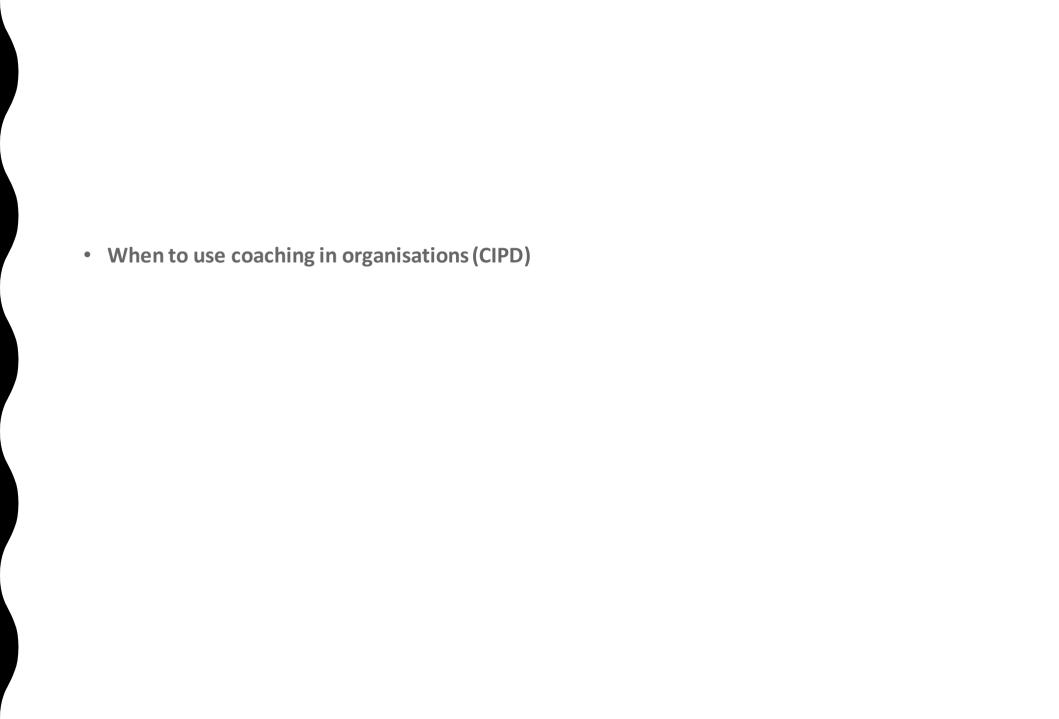
7 minute read
Reasonsfor using coaching?
• A rapidly evolving business environment. Dealing with change is becoming an everyday challenge. The ability to learn and adapt is quickly becoming an essential skill.
• The features of modern organisations. Flatter organisational structures,broadermanagement roles and lower job security have also been contributing factors to the growth of coaching. Newly promotedindividuals often have to make large step changes in skills, responsibilities and performance.
Advertisement
• Lifelong Learning. Coaching has the adaptability to support different learning styles so may be able to support more employees than traditional trainingmethods.
• The need for targeted, individualised, just-in-time development.
• The financial costs of the poor performanceof senior managers/executives.Coaching provides organisations with an opportunity to undertake pre-emptive and proactive interventions to improve their performance.
• Improving the decision-making of senior employees. A coach can be used to provide a ‘safe and objective haven’ to discuss issues and give support.
• Individual responsibility for development. Coaching can help individuals identify development needs, plan development activities and support personal problem-solving.
• Employee demand for different types of training. Research has frequently demonstratedthat people are more motivatedand learn best when they see that the training is relevant to their job. Coaching, with its focus on work issues and improvingjob performance, fits in well with this.
• Support for other learning and development activities.Coaching is a valuable way of providing ongoing support for personaldevelopment plans.
• A popular development mechanism. People enjoy participating in coaching.
• When to use coaching in organisations (CIPD) https://richardwinfield.com/coaching-3/when-to-usecoaching/
• Systemic coaching
PeterHawkinsand Nick Smith
• “Coaching, Mentoring and OrganisationalConsultancy”something like this:
• In systemiccoaching, the coaches will be askingthemselves:
• What needs to change in the wider system and in turn?
• What shift does this require in the individual or team I am coaching?
• What change in behaviours does this require in the coachee(s)?
• So what questions do I need to ask to make this happen?
• The coaches are, in their one-to-one conversations, basically helping effect an organisation-wide change through helping the individual(s) change their behaviours.
• This is a more directional type of coaching, rather than a free-flowing conversation based entirely aroundwhat the coachee wants to focus on.
• Strategiccoaching helps you identify needs before they become problems. This proactive approach opens up opportunities for learning before an urgent change is required – and it increasesthe chances of success for everyone involved.
• Coaching Culture
• A coaching culture simply means supporting your employees so that they learn new skills and become greater assets to the company. A management culture that emphasizes training, regularfeedback, and opportunities for growth creates a more engaged and energized workforce.
• The benefits of a coaching culture. ... Coaching in the workplace improves leadership development. It also improves employee engagement,communication skills and teamwork in the company. Businesses that value the importance of coaching have seen significant results in employee engagement and financial productivity.
•
What is a CoachingCulture? Parsloe(2016)
• If you could be a ‘fly on the wall’ in a coaching culture, here’s what you’d see:
• Managerslooking for opportunities to help others to learn
• People asking each other open questions
• Employees at all levels having open, honest and supportiveconversationswith one another
• People routinely giving one another feedback - supportive and critical
• Managerscoaching team members to help them develop, rather than just to tackle poor performance
• Coaching and mentoring relationships forming spontaneously
• Senior leaders with a clear vision that coaching and mentoringare at the heart of how we operate
• Teams working with clear goals, roles, processes and relationships
• Relatively few people will be ‘playingpolitics’
• A pragmatic focus on delivering results and at the same time building the long-term health of the business
• How to create a “coaching culture” Parsloe (2016)
• The first step is to create clear vision for the culture. It doesn’t have to be a perfect picture but it does need to be inspiring! How will the culture help you deliver the strategy? What’s in it for leaders – and for all employees? How will it benefit your customers/ shareholders?
• It’s also important to know where you’re coming from. You can conduct a ‘readiness audit’ to find out how much coaching and mentoring are already happening in your organisation. And how receptive people are to doing things differently.
• And it’s important to have some first steps. In the early stages of creating a coaching culture, there’s often more reliance on external coaches and external support. But this reliance soon drops away as you train a cohort of internal coaches and/or mentors – as well as leaders who use a coaching approach in their daily lives. This trickles down to how employees treat each other.
• Creating a coaching culture takes time but doesn’t always take a lot of investment if it’s done in a savvy way. Parsloe (2016) https://www.koganpage.com/article/what-is-a-coaching-culture
• Creating a Coaching Culture Bishop (2018)
• “Creating a coaching culture at work has several benefits for you and your employees. Staff are given development opportunities and therefore likely to feel more valued and motivated. In turn, the business can mitigate the risk of high staff turnover and save money on recruitment by encouraging progression and promoting from within” Bishop (2018)
• Top employee desires in the workplace are:
• To feel appreciated and valued
• To gain a deeper understanding of their role in the business
• To feel a deeper social connection to their colleagues
• To achieve a greater work life balance
• The top benefits to a vibrant and constantly evolving coaching culture in the workplace are:
• Improving employees sense of purpose
• Boosting morale and employee motivation
• Increasing productivity through skill development
• Improving internal communication and rapport across the business
• Improving employee engagement
• Improving employee wellbeing
• Reducing the need to recruit externally for senior roles
• Reducing employee turnover
• Bishop (2018)
Coaching That Counts , Harnessing the Power of LeadershipCoaching to DeliverStrategicValue
Dianna L. Anderson, MCC , Merrill C. Anderson, Ph.D (2003)
• Benchmarked companies known to have outstanding coaching programs.Severalthemes emerged:
• All companies had dedicated staff to support the initiatives
• Coaching was viewed as part of a strategic initiative of the organization to turn the quality of its leaders into a competitive advantagefor the firm
• Coaching was integratedwith other leadership development programs and competency growth
• All viewed coaching as an investment in top performers or high potentials.
• External coaches were preferred in order to maintain confidentialityand reduce feelings of vulnerability in the most senior staff
• Critical Success Factors
• The concept of CSFs (also known as Key Results Areas, or KRAs) was first developed by D. Ronald Daniel, in his article "Management Information Crisis" (Harvard Business Review, SeptemberOctober 1961). John F. Rockart, of MIT's Sloan School of Management, built on and popularized the idea almost two decades later.
• Rockart defined CSFs as: "The limited number of areas in which results, if they are satisfactory, will ensure successful competitive performance for the organization. They are the few key areas where things must go right for the business to flourish. If results in these areas are not adequate, the organization's efforts for the period will be less than desired."
• Rockart also concluded that CSFs are "areas of activity that should receive constant and careful attention from management."
• A Key Performance Indicator (KPI) is a measurable value that demonstrates how effectively a company is achieving key business objectives. Organizations use KPIs to evaluate their success at reaching targets. ... Selecting the right one will depend on your industry and which part of the business you are looking to track.
•
The Golden Thread Framework for setting Organisational Objectives
• The 'Golden Thread' is a metaphor for the decisions, data / analytical processes, technology, and human behaviour that link strategy and results. Each bend, twist and cut of the thread reduces the quality of the gold delivered at the end of the process.
• The Golden Thread is a simple framework for aligning performance metrics with organisational objectives, and therefore individual goals throughout each layer of the business. Though Golden Thread is a term found across many different disciplines and taken to mean many different things, in the world of business it is used to describe a performance model which seeks to align organisational objectives with accurate measures of success.
• The thread seeks to connect the organisational vision with analyses, processes, systems and people; leading to a common understanding as to how the vision, goals and values of the organisation are intrinsically linked to everyday tasks. This alignment is crucial if the business is to improve on a sustainable and consistent basis.
• The model places emphasis on the processes which occur at the middle management stage of the organisational process. This stage is often overlooked in other models; however, it is crucial to the oversight of day-to-day tasks, and to the performance and contributions of lower-level employees.
The stages of the Golden Thread create a link between key success factors/performance measures and the overall strategy of the organisation. As employees buy-in to organisational strategy and this shared purpose, it motivates them to make conscious contributions to day-to-day tasks, for which they are accountable. This means that those who deliver on desired objectives have true ownership over their results, and can be recognised or rewarded as such.
At each stage, specificmetrics should be identified which can be used to provide a true insightinto the performance of the organisation and project, and can be used to set individualgoals which are specific and truly contribute to progress. A scorecard can be usedto define these metrics, and the flowchart can be used to subsequently design a plan of action to achieve organisational objectives.
• Kaplan and Norton balanced scorecard 1996
• A balanced scorecard is a strategic management performance metric used to identify and improve various internal business functions and their resulting external outcomes. Balanced scorecards are used to measure and provide feedback to organizations. The balanced scorecard (BSC) is a strategic planning and management system that organizations use to:
•
• Communicate what they are trying to accomplish
• Align the day-to-day work that everyone is doing with strategy
• Prioritize projects, products, and services
• Measure and monitor progress towards strategic targets
• A key benefit of using a disciplined framework is thatit gives organizations a way to “connect the dots” between the various components of strategic planning and management, meaning that there will be a visible connection between the projects and programs that people are working on, the measurements being used to track success (KPIs), the strategic objectives the organization is trying to accomplish, and the mission, vision, and strategy of the organization.
•
• TECHNIQUES FOR COACHING AND MENTORING SECOND EDITION
Lancer, Clutterbuck and Megginson (2017)








